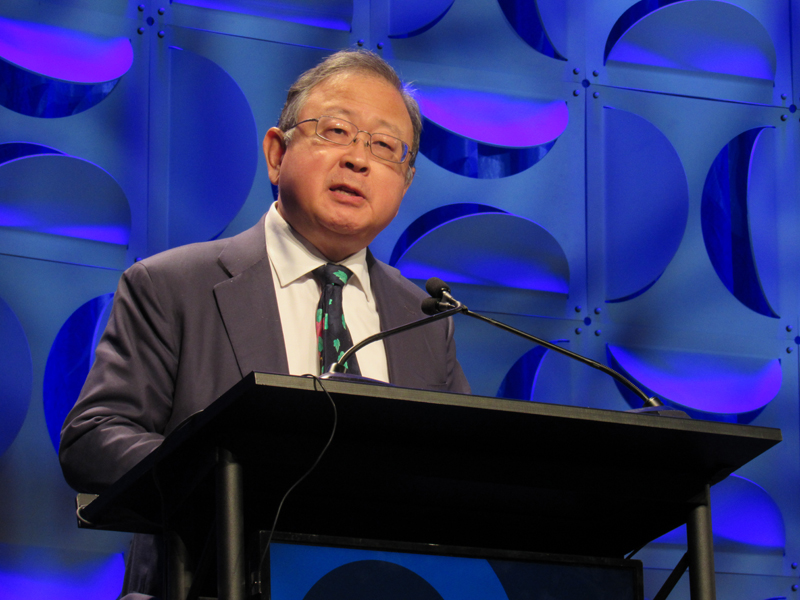Romosozumab increases bone density across varying levels of renal function

ATLANTA — Romosozumab increases bone mineral density among patients with osteoporosis across different levels of renal function, according to a presenter at ACR/ARP 2019.
“Osteoporosis and renal insufficiency are coexisting disease states in a substantial proportion of postmenopausal women,” Jonathan Adachi, MD, of McMaster University, Hamilton, Ontario, Canada, told attendees. “Prescribing information for bisphosphonates warns against using these agents for patients with an estimated [glomerular filtration rate] of less than 30 or 35 mL per minute. Therefore, it is important to evaluate other osteoporosis treatments in this setting.”
To examine the safety and efficacy of romosozumab (Evenity, Amgen), compared with placebo, among patients with osteoporosis with varying levels of renal insufficiency, Adachi and colleagues conducted a post hoc analysis of the FRAME study. According to Adachi, FRAME enrolled 7,180 post-menopausal women with T-scores of –2.5 to –3.5 at the total hip or femoral neck. In the placebo-controlled double-blind phase of the study, participants received monthly doses of either 210 mg of romosozumab or placebo for 1 year.

In addition, all participants were grouped by baseline estimated glomerular filtration rate (eGFR), normalized to body surface area, determined using the Modification of Diet in Renal Disease study equation. Subgroups included normal renal function, defined as an eGFR of 90 or greater; mild, set at 60 to 90; moderate, defined as 30 to 59; and severe, with an eGFR of 15 to 29. The researchers assessed least squares mean percentage changes in bone mineral density at the lumbar spine, total hip and femoral neck, as well as the incidence of new fractures and adverse events, for each subgroup from baseline to 12 months.
According to the researchers, among the overall participant population, the mean change in bone mineral density in the lumbar spine from baseline was 13.1% (95% CI, 12.8-13.3) for the romosozumab group, compared with 0.4% (95% CI, 0.2-0.5) among those who received placebo. For the total neck, mean changes were 6% (95% CI, 5.9-6.2) for those treated with romosozumab, compared with 0.3% (95% CI, 0.1-0.4) in the placebo group, while the figures for the femoral neck were 5.5% (95% CI, 5.2-5.7) and 0.3% (95% CI, 0.1-0.5) respectively.
In addition, changes in bone mineral density were similar across baseline eGFR scores. The incidence of new fractures in participants with normal renal function was 0.5% in those treated with romosozumab and 3% in those who received a placebo. Among those with mild renal insufficiency, the new fracture incidences were 0.4% and 1.5% respectively. In the moderate subgroup, these figures were 0.6% and 2.1% respectively. Approximately 80% of participants in each group demonstrated no changes from baseline eGFR category at the end of 1 year.
The overall incidence of adverse events, serious adverse events and positively adjudicated cardiovascular events were similar across all treatment groups in all eGFR categories.
“Large gains in [bone mineral density] were achieved with romosozumab vs. placebo, irrespective of renal function level,” Adachi said. “Risk of new vertebral fractures was decreased in all eGFR subgroups and did not appear to be affected by eGFR level. Safety of romosozumab was generally comparable among eGFR subgroups. Romosozumab could be considered a treatment option for osteoporotic patients with mild-to-moderate chronic kidney disease.” – by Jason Laday
Reference:
Miller P. Abstract #2730. Efficacy and safety of romosozumab vs. placebo among patients with mild-to-moderate chronic kidney disease. Presented at: American College of Rheumatology/Association of Rheumatology Professionals Annual Meeting; Nov. 9-13, 2019; Atlanta.
Disclosure: Adachi reports professional relationships with AbbVie, Amgen, Eli Lilly, Pfizer and UCB.







